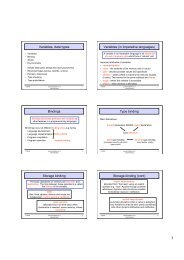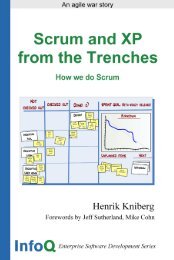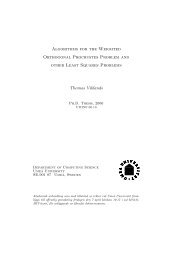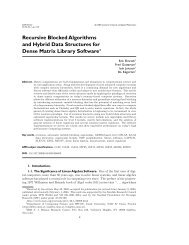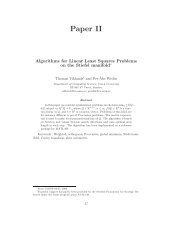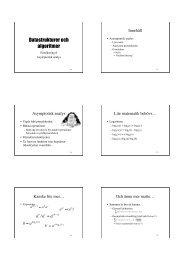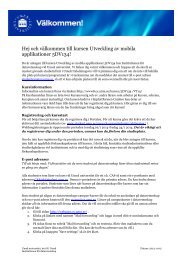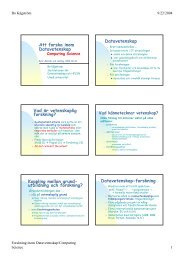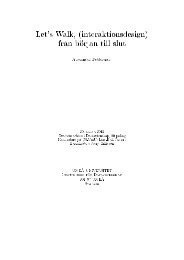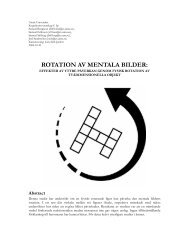Object Tracking and Face Recognition in Video Streams
Object Tracking and Face Recognition in Video Streams
Object Tracking and Face Recognition in Video Streams
- No tags were found...
You also want an ePaper? Increase the reach of your titles
YUMPU automatically turns print PDFs into web optimized ePapers that Google loves.
2 Chapter 1. Introductiona frontal picture, or it may only recognise a face <strong>in</strong> a particular “ideal”, or neutral, state.When the system fails, it can be by identify<strong>in</strong>g the face as belong<strong>in</strong>g to the wrong person,or it can be by fail<strong>in</strong>g to make an identification at all.This project aims to improve the ability to recognise a person <strong>in</strong> a non-ideal state orangle. By track<strong>in</strong>g how a face moves, the system has the potential to recognise that it isthe same face when it moves between an ideal <strong>and</strong> a non-ideal state or angle, even if Wawono longer recognises it. The system can then make a qualified guess that the identity is thesame <strong>in</strong> the two (or more) states. If Wawo makes contradictory identifications for a s<strong>in</strong>gleface <strong>in</strong> different frames, the identity that occurs most often can reasonably be assumed tobe the right one.The goal is to use a system called OpenTLD (Kalal, 2011b). It is an implementationof TLD, which is a set of algorithms that h<strong>and</strong>le object track<strong>in</strong>g <strong>in</strong> video streams, whichbasically means that the system tracks where objects move between frames. TLD has thebonus of be<strong>in</strong>g adaptive, mak<strong>in</strong>g it more flexible than the OpenCV face detector. Theorig<strong>in</strong>al OpenTLD is written <strong>in</strong> Matlab, but some C++ ports should be explored <strong>and</strong> used<strong>in</strong>stead if possible.The <strong>in</strong>tegration of OpenTLD with Vidisp<strong>in</strong>e will be general, allow<strong>in</strong>g it <strong>in</strong> theory totrack any object. This will be accomplished by writ<strong>in</strong>g a general plug<strong>in</strong> for object track<strong>in</strong>g.The general object-track<strong>in</strong>g plug<strong>in</strong> will then used by the face recognition plug<strong>in</strong> to trackfaces.An object can be tracked both forwards <strong>and</strong> backwards <strong>in</strong> a video stream. <strong>Track<strong>in</strong>g</strong> anobject forwards is obvious, <strong>and</strong> is the first th<strong>in</strong>g that should be implemented. If the faceis only found <strong>in</strong> the middle of a scene, it may also be worth it track<strong>in</strong>g the face backwardsto see see how long it has been there. Therefore, support for track<strong>in</strong>g backwards should beexplored.A library called <strong>Face</strong>clip (Rondahl, 2011) will be evaluated to see whether it is betterthan the current system at detect<strong>in</strong>g faces <strong>in</strong> a frame, <strong>and</strong> may take over that task. Likethe current code, <strong>Face</strong>clip is based on OpenCV. It has, however, been adjusted to do abetter job, ma<strong>in</strong>ly by perform<strong>in</strong>g a larger number of tests. Before mak<strong>in</strong>g the decision touse <strong>Face</strong>clip, it should be evaluated; both the results <strong>and</strong> the performance should be taken<strong>in</strong>to account to some degree.The current Wawo-based code will be used to do the actual face identification. A bonusfeature is to add support for detect<strong>in</strong>g <strong>and</strong> report<strong>in</strong>g the direction of a face <strong>in</strong> a given frame.The two transcoder plug<strong>in</strong>s: object track<strong>in</strong>g <strong>and</strong> face detection/identification, will becomb<strong>in</strong>ed <strong>in</strong> a higher level face-recognition transcoder plug<strong>in</strong>.The current plug<strong>in</strong> will be used as the reference system when evaluat<strong>in</strong>g the recognitionresults <strong>and</strong> performance of the project.In short, the goals for this project are:G1 Create a transcoder plug<strong>in</strong> for object track<strong>in</strong>g, us<strong>in</strong>g OpenTLD, <strong>and</strong> <strong>in</strong>tegrate it withthe face recognition plug<strong>in</strong>. The first goal is to track objects forward.G2 Support track<strong>in</strong>g objects backwardsG3 Implement <strong>and</strong> evaluate <strong>Face</strong>clip as an alternative to the current face detection code.G4 Support f<strong>in</strong>d<strong>in</strong>g the direction of detected faces.


